3. Digital Management
This chapter provides an overview of all the capabilities, value streams, functional components, and data objects that introduce and structure the IT4IT Reference Architecture. In the IT4IT Standard this is referred to as Level 1.
At the most basic level, the IT4IT Standard defines the “Digital Management” of “Digital Products” in order to create an efficient value delivery. This is illustrated in Figure 1.

The IT4IT Standard is about defining the value stream, the associated functions, and the data objects needed to control the planning, development, delivery, and run management of Digital Products. This can be seen as a factory for Digital.
In the rest of this chapter we will outline:
-
The groups of functionality needed for managing digital
-
The decomposition of the digital value stream
-
The necessary underlying functionality and data models
The detailed normative definition of this can be found in Chapters 5 to 10.
3.1. The IT4IT Functionality Groups
Functionality groups provide an abstraction of what is needed to manage the new digital reality in a way that helps to simplify conversations between interested stakeholders. In the IT4IT Standard, we use it to describe a collection of functionality and data that is responsible for a well-defined part of the overall value creation. We describe the groups at a high level, and we decompose one level to have well-defined categories for defining the Supporting Functionality.
The IT4IT Standard defines four IT4IT groups of functions that deliver the outcome for the high-level IT4IT Value Stream. These are known from previous versions of the IT4IT Standard as making up the IT4IT Value Chain:
-
Chapter 6 defines the functionality used to mange a digital strategy and portfolio
This was formerly known as the Strategy to Portfolio (S2P) group
-
Chapter 7 defines the functionality used to build a Digital Product from its defined requirements
This was formerly known as the Requirement to Deploy (R2D) group
-
Chapter 8 defines the functionality used to deploy and consume a Digital Product
This was formerly known as the Request to Fulfill (R2F) group
-
Chapter 9 defines the need functionality used to detect issues and correct them in order to ensure products run as expected
This was formerly known as the Detect to Correct (D2C) group
In addition to these four IT4IT functional groups, digital management depends on a set of Supporting Functions. The IT4IT standard defines six of these in Chapter 10.
The Supporting Functions are only defined in terms of the minimum functionality they need to deliver in order to support the core of the IT4IT Reference Architecture. Other standards define these capabilities in much more detail and it is not our aim to compete with these standards.
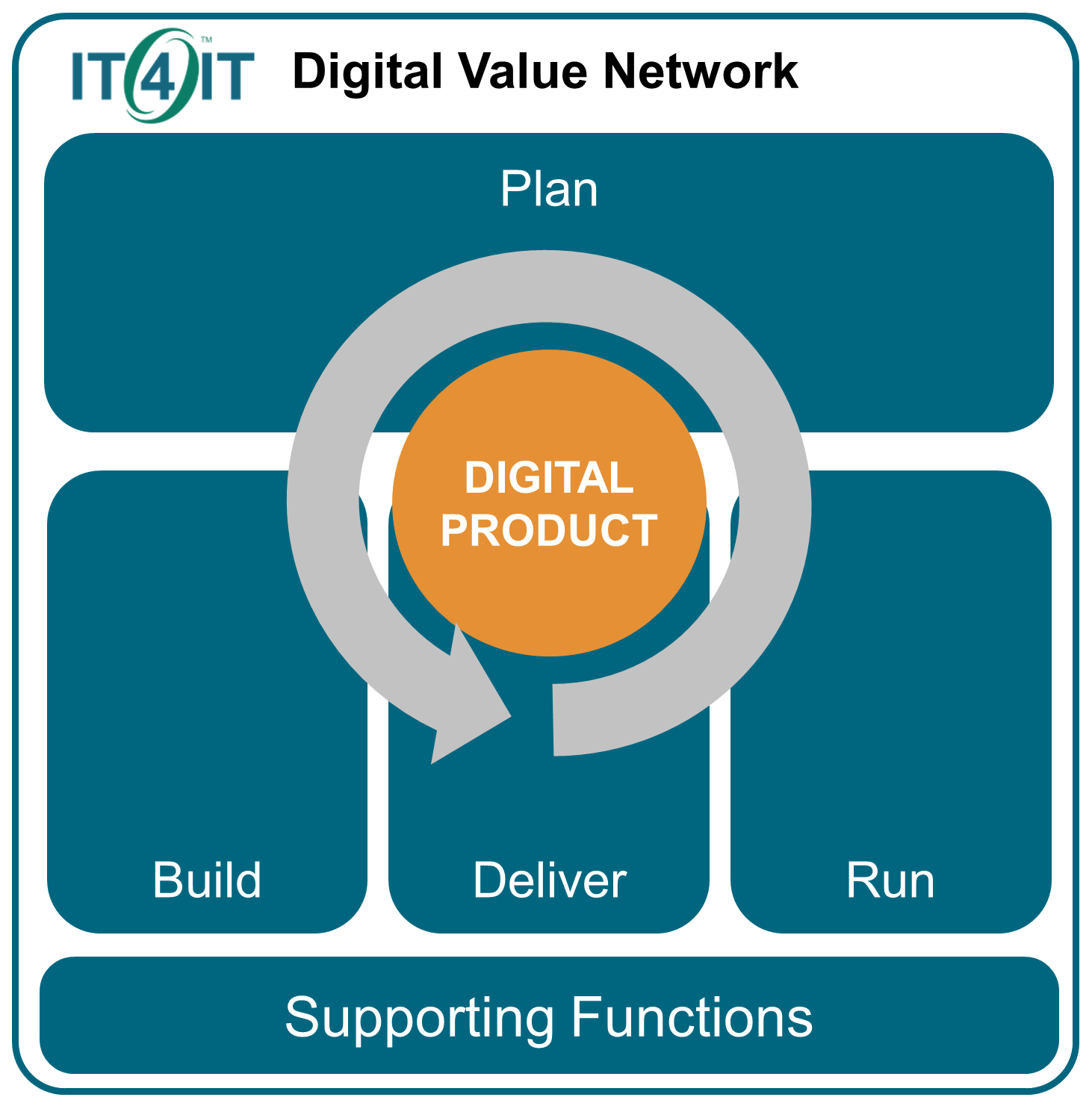
Figure 2 illustrates how the capabilities work together, with the IT4IT Value Streams and the associated decomposition of the concept of a Digital Product.
3.2. The Digital Value Network
A traditional model for defining factories is Porter’s Value Chain concept [Porter]. This revision of the IT4IT Standard breaks with the Value Chain model and moves to the more recent concept of Value Networks. This reflects that value creation is a complex interaction within many systems and organizations.
In Figure 3, it is recognized that in addition to the core value stream for managing digital, a complex interaction with a number of supporting capabilities in an enterprise is needed. These functions are not at the heart of the IT4IT Standard, as other standards and frameworks have these functions and capabilities as a focal point.
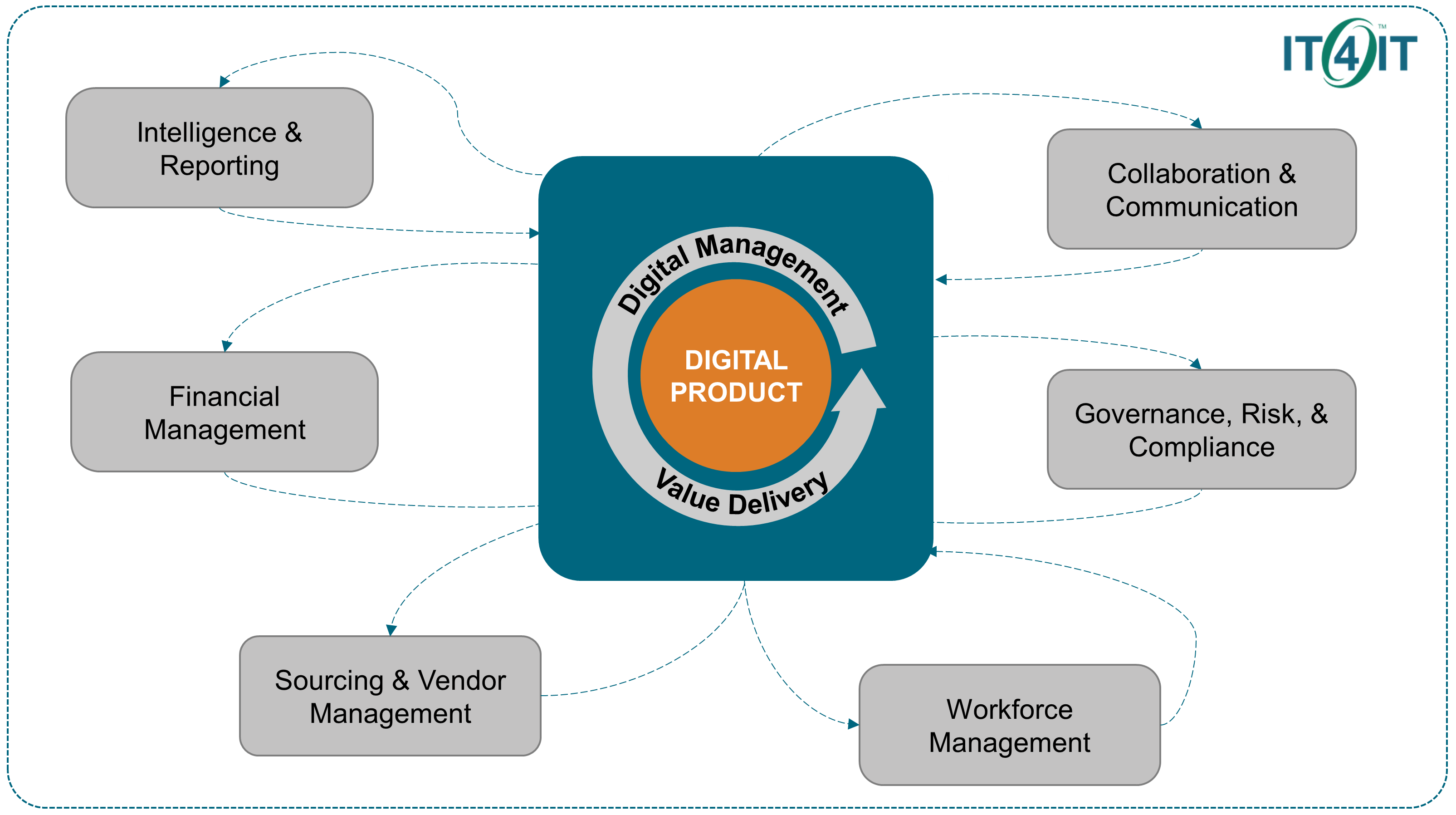
The Value Network is further defined through the interaction of the Digital Product with customers, business partners, vendors, as well as government and regulatory entities. The Digital Product is creating value for its consumers. The business partners and service providers can both provide resources for delivering Digital Products as well as creating their own value using the Digital Products delivered through the IT4IT Standard. As you develop Digital Products you must comply with government and regulatory rules and thus participate in the value creation of society; see Figure 4.
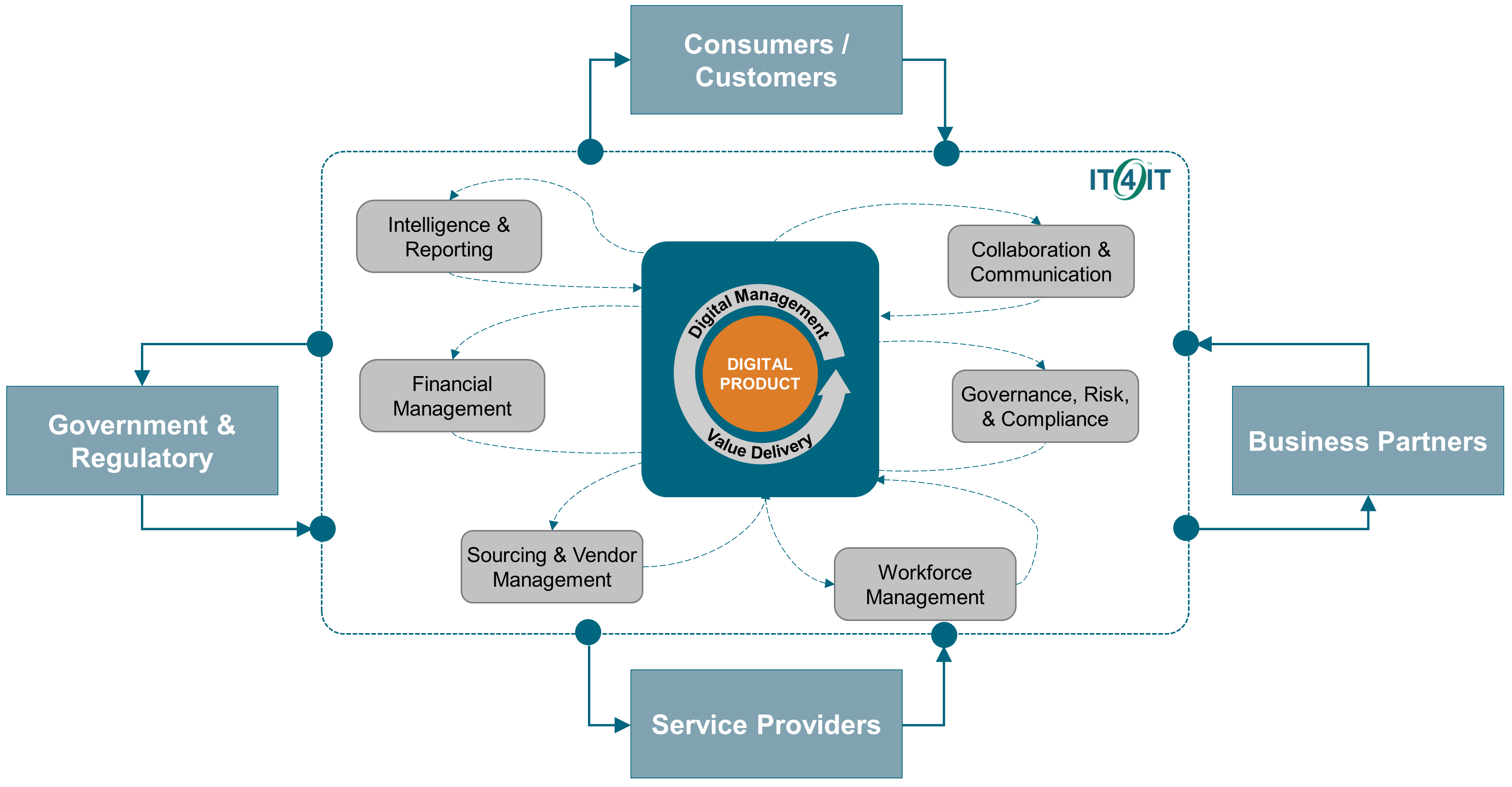
3.3. The Seven IT4IT Value Streams
For the second decomposition, a split is made with the Digital Product as an abstract entity in a set of data objects that form the essence of the Digital Product Backbone. This is complemented with seven new value streams that, together, explain how to define and manage the delivery of digital value.
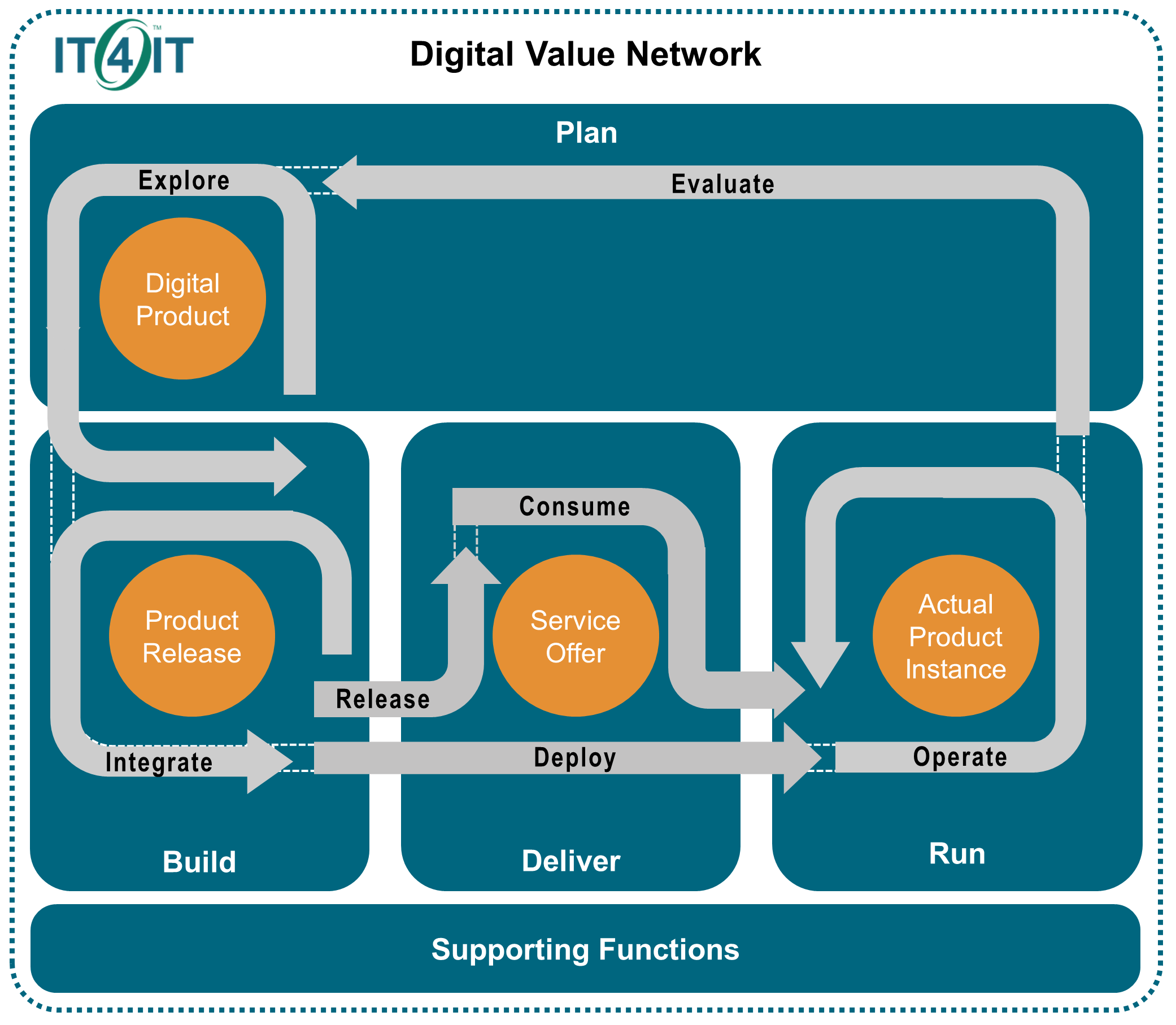
A value stream represents a sequence of activities that creates an overall result for a customer, stakeholder, or end-user. As shown in Figure 5, the complete set of value streams depicts the various ways in which an organization orchestrates its capabilities to create stakeholder value through Digital Products. The value stream has a direct linkage to an organization’s business model (specifically to the value proposition). As an organization translates its business model to an operating model, those value stream stages can be translated into digital delivery processes as well as related data objects, tools, integrations, etc.
This document defines the following seven value streams: Evaluate, Explore, Integrate, Deploy, Release, Consume, and Operate.
These value streams are briefly introduced and described in the following sections.
3.3.1. Evaluate
This value stream is about the continuous assessment and evaluation of the entire Digital Product Portfolio to optimize the alignment of the Product Portfolio with the business strategy, including the identification of new Digital Product opportunities that support business and technology objectives.
The Evaluate value stream is described formally in Section 5.1.
3.3.2. Explore
This value stream continuously explores new features and/or future directions of a Digital Product aligned with strategic direction and business needs. It ensures the Product Design evolves to facilitate innovation and optimize business outcomes.
The Explore value stream is described formally in Section 5.2.
3.3.3. Integrate
This value stream continuously designs and builds new Product Releases and makes them ready for deployment to the market or the business. The Product Release is not limited to software development; this value stream is also applicable for the development of infrastructure building blocks and workplace services. The Product Release may be as large as an entire new product or as small as a hotfix or a patch.
The Integrate value stream is described formally in Section 5.3.
3.3.4. Deploy
This value stream deploys a Product Release into a production/operating environment (creating a new instance or updating/removing an existing instance). This scope of this value stream includes many different strategies for deploying Product Releases.
The Deploy value stream is described formally in Section 5.4.
3.3.5. Release
This value stream provides consumers with digital Service Offers that represent a new instance of a Digital Product or a change (including decommissioning) to an existing instance. A Service Offer defines how to subscribe to a Digital Product and all other lifecycle interactions the instance will have with its consumers, stakeholders, and support. The Service Offer can be made available for consumption through a self-service portal or through Application Program Interfaces (APIs).
The Release value stream is described formally in Section 5.5.
3.3.6. Consume
This value stream is triggered when an entitled human or system actor accepts a Service Offer related to a Digital Product. The value stream should support customer self-service and is not limited to a single engagement channel. It orchestrates the actions required to fulfill consumption of the offered service to ensure that the desired Digital Product is delivered within the agreed terms.
The Consume value stream is described formally in Section 5.6.
3.3.7. Operate
This value stream manages the continuous operations of a deployed instance of a Digital Product in a continuous manner. It is responsible for maintaining availability and performance within the boundaries of agreed Service Contracts. The scope of this value stream includes managing any compliance and security aspects of running Digital Product Instances and underlying systems.
The Operate value stream is described formally in Section 5.7.
3.4. Introducing Functional Components and the Data Model
The seven IT4IT Value Streams are normatively defined in Chapter 5. The definitions have a central theme – the data objects used and controlled by the value streams in order to manage the Digital Product.
A data object must be controlled by applications. The IT4IT Standard defines the application building blocks for managing Digital as functional components.
In the IT4IT Standard, a decomposition is made from the four high-level functional groups to the eight (sub-) functional groups that must be established in order to manage Digital Products.
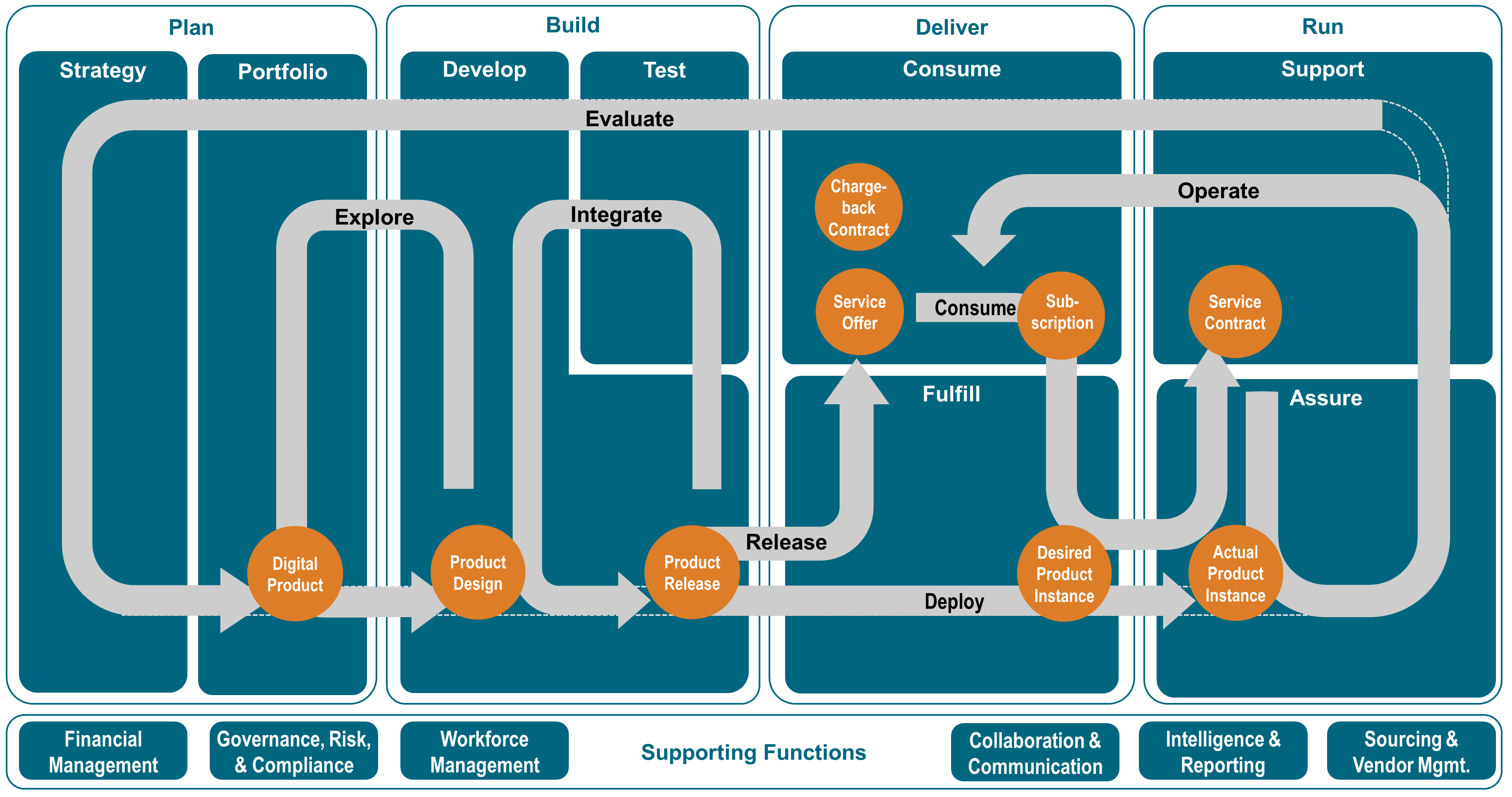
These eight functional groups shown in Figure 7 are then populated by 33 functional components that control 44 key data objects. The 44 data objects are manipulated as the seven value streams are exercised: exploring, integrating, deploying, releasing, consuming, operating, and evaluating the Digital Products.
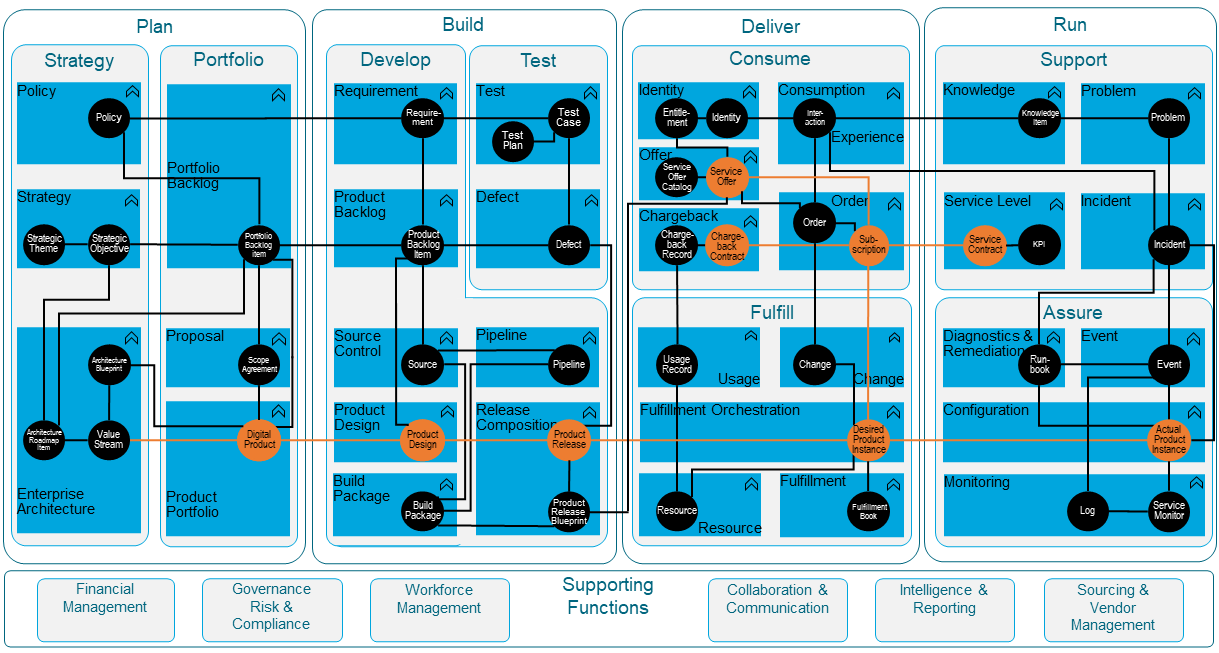
3.5. Summary
The IT4IT Standard defines seven value streams that control the Digital Products. Information on the Digital Products is tracked through a set of interconnected data objects that is managed by functional components. These are the components at the center of delivering the Digital Management capabilities, as illustrated in Figure 8.
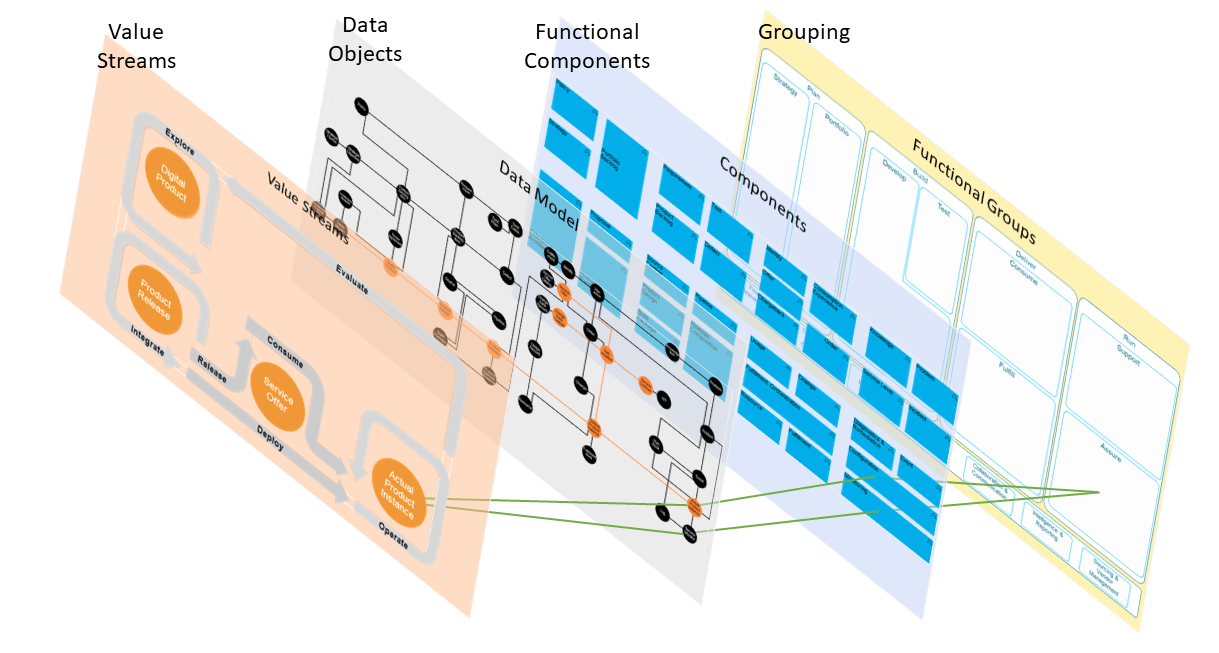
Combining the value streams with the four high-level functional groups results in Figure 5. Combining the value streams with the eight sub-level functional groups results in Figure 6. Combining the data objects with functional components and functional groups results in Figure 7.
For details on the formal object types, metamodels, and associated ArchiMate solution patterns used in Chapter 11, a quick reference card can be seen in Figure 9.